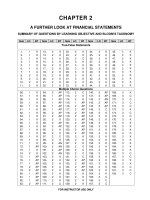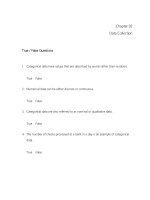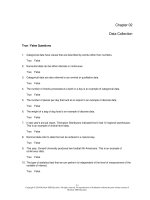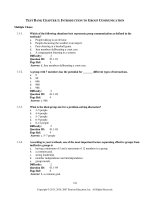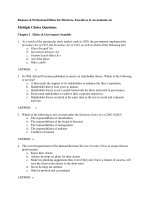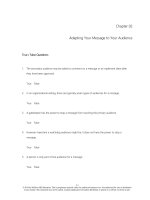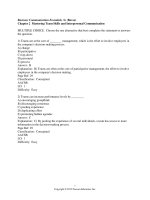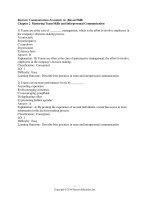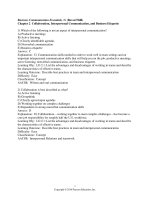Business in action 6th edition bovee test bank
Bạn đang xem bản rút gọn của tài liệu. Xem và tải ngay bản đầy đủ của tài liệu tại đây (219.96 KB, 43 trang )
Business in Action, 6e (Bovee/Thill)
Chapter 2 Understanding Basic Economics
1) Economics is the study of how a society uses its scarce resources to produce and distribute
goods and services to its citizens.
Answer: TRUE
Explanation: Economics is the study of how a society uses its scarce resources to produce and
distribute goods and services to its citizens.
Page Ref: 26
Difficulty: Easy
AACSB: Dynamics of the Global Economy
Chapter LO: 1
Course LO: Compare and contrast different economic systems
Classification: Concept
2) Macroeconomics studies economic behavior among consumers, businesses, and industries that
collectively determine the quantity of goods and services demanded and supplied at different
prices.
Answer: FALSE
Explanation: The study of a country's larger economic issues, such as how firms compete, the
effect of government policies, and how an economy maintains and allocates its scarce resources,
is termed macroeconomics.
Page Ref: 26
Difficulty: Easy
AACSB: Dynamics of the Global Economy
Chapter LO: 1
Course LO: Compare and contrast different economic systems
Classification: Concept
3) Capital includes land and minerals that a business needs in order to produce goods and
services.
Answer: FALSE
Explanation: Capital includes money, computers, machines, tools, and buildings that a business
needs in order to produce goods and services.
Page Ref: 26
Difficulty: Easy
AACSB: Dynamics of the Global Economy
Chapter LO: 1
Course LO: Compare and contrast different economic systems
Classification: Concept
1
Copyright © 2013 Pearson Education, Inc. publishing as Prentice Hall
4) Capital is the collective intelligence of an organization.
Answer: FALSE
Explanation: Capital includes money, computers, machines, tools, and buildings that a business
needs in order to produce goods and services.
Page Ref: 26
Difficulty: Easy
AACSB: Dynamics of the Global Economy
Chapter LO: 1
Course LO: Compare and contrast different economic systems
Classification: Concept
5) Scarcity creates competition for resources, and forces trade-offs on the part of every
participant in the economy.
Answer: TRUE
Explanation: Scarcity has two powerful effects: It creates competition for resources, and it
forces trade-offs on the part of every participant in the economy.
Page Ref: 27
Difficulty: Moderate
AACSB: Dynamics of the Global Economy
Chapter LO: 1
Course LO: Compare and contrast different economic systems
Classification: Concept
6) Deciding how much money to spend on new manufacturing equipment versus launching a
new advertising campaign is described as opportunity cost.
Answer: FALSE
Explanation: Opportunity cost refers to the value of the most appealing alternative from all those
that weren't chosen. In other words, opportunity cost is a way to measure the value of what you
gave up when you pursued a different opportunity.
Page Ref: 28
Difficulty: Moderate
AACSB: Analytic Skills
Chapter LO: 1
Course LO: Compare and contrast different economic systems
Classification: Application
2
Copyright © 2013 Pearson Education, Inc. publishing as Prentice Hall
7) Capitalism is a term used to describe the free-market system, one in which private parties own
and operate the majority of businesses and where competition, supply, and demand determine
which goods and services are produced.
Answer: TRUE
Explanation: Capitalism is a term used to describe the free-market system, one in which private
parties own and operate the majority of businesses and where competition, supply, and demand
determine which goods and services are produced.
Page Ref: 28
Difficulty: Easy
AACSB: Dynamics of the Global Economy
Chapter LO: 2
Course LO: Compare and contrast different economic systems
Classification: Concept
8) In practice, no economy is truly a free-market economy.
Answer: TRUE
Explanation: Free market economy is a situation in which so many buyers and sellers exist that
no single buyer or seller can individually influence market prices. In practice, no economy is
truly a free-market economy.
Page Ref: 29
Difficulty: Easy
AACSB: Dynamics of the Global Economy
Chapter LO: 2
Course LO: Compare and contrast different economic systems
Classification: Concept
9) As social equality is a major goal of planned systems, private enterprise and the pursuit of
private gain are encouraged.
Answer: FALSE
Explanation: In a planned system, governments largely control the allocation of resources and
limit freedom of choice in order to accomplish government goals. Private enterprise and the
pursuit of private gain are not encouraged in such a system.
Page Ref: 29
Difficulty: Moderate
AACSB: Dynamics of the Global Economy
Chapter LO: 2
Course LO: Compare and contrast different economic systems
Classification: Concept
3
Copyright © 2013 Pearson Education, Inc. publishing as Prentice Hall
10) By taking an ownership of 60% in General Motors in 2009, the U.S. nationalized the
automaker.
Answer: TRUE
Explanation: Nationalizing refers to a government's takeover of selected companies or
industries. In the given situation, the government has attained a majority stake and the situation
is an example of nationalization.
Page Ref: 30
Difficulty: Moderate
AACSB: Analytic Skills
Chapter LO: 2
Course LO: Compare and contrast different economic systems
Classification: Application
11) Demand refers to the quantities of a good or service that producers will provide on a
particular date at various prices.
Answer: FALSE
Explanation: Demand refers to buyers' willingness and ability to purchase products at various
price points.
Page Ref: 31
Difficulty: Easy
AACSB: Dynamics of the Global Economy
Chapter LO: 3
Classification: Concept
12) The demand curve will shift to the left if the price of substitute products increases.
Answer: FALSE
Explanation: The demand curve will shift to the right if the price of substitute products
increases.
Page Ref: 31
Difficulty: Moderate
AACSB: Analytic Skills
Chapter LO: 3
Classification: Application
13) Movement along the supply curve typically slopes upward.
Answer: TRUE
Explanation: Movement along the supply curve typically slopes upward: As prices rise, the
quantity that sellers are willing to supply also rises. Similarly, as prices decline, the quantity that
sellers are willing to supply declines.
Page Ref: 32
Difficulty: Moderate
AACSB: Analytic Skills
Chapter LO: 3
Classification: Concept
4
Copyright © 2013 Pearson Education, Inc. publishing as Prentice Hall
14) The supply curve of a firm will shift to the right if technology increases the firm's production
costs.
Answer: FALSE
Explanation: The supply curve of a firm will shift to the left if technology increases the firm's
production costs.
Page Ref: 32
Difficulty: Moderate
AACSB: Analytic Skills
Chapter LO: 3
Classification: Application
15) The point at which quantity of a good or service equals the quantity demanded is known as
the equilibrium point.
Answer: TRUE
Explanation: The point at which quantity of a good or service equals the quantity demanded is
known as the equilibrium point.
Page Ref: 32
Difficulty: Easy
AACSB: Dynamics of the Global Economy
Chapter LO: 3
Classification: Concept
16) The situation in which one supplier thoroughly dominates a market and essentially shuts out
other competitors is called monopoly.
Answer: TRUE
Explanation: The situation in which one supplier thoroughly dominates a market and essentially
shuts out other competitors is called monopoly.
Page Ref: 35
Difficulty: Easy
AACSB: Dynamics of the Global Economy
Chapter LO: 4
Course LO: Compare and contrast different economic systems
Classification: Concept
17) A deep and prolonged recession can be considered as a depression.
Answer: TRUE
Explanation: A deep and prolonged recession can be considered a depression, which doesn't
have an official definition but is generally considered to involve a catastrophic collapse of
financial markets.
Page Ref: 36
Difficulty: Easy
AACSB: Dynamics of the Global Economy
Chapter LO: 4
Course LO: Compare and contrast different economic systems
Classification: Concept
5
Copyright © 2013 Pearson Education, Inc. publishing as Prentice Hall
18) Frictional unemployment is caused by economic fluctuations.
Answer: FALSE
Explanation: Frictional unemployment refers to the natural flow of workers into and out of jobs,
such as when a person leaves one job without first lining up a new job.
Page Ref: 36
Difficulty: Easy
AACSB: Dynamics of the Global Economy
Chapter LO: 4
Course LO: Compare and contrast different economic systems
Classification: Concept
19) Deflation is an economic condition in which prices fall steadily throughout the economy.
Answer: TRUE
Explanation: Deflation is an economic condition in which prices fall steadily throughout the
economy.
Page Ref: 36
Difficulty: Easy
AACSB: Dynamics of the Global Economy
Chapter LO: 4
Course LO: Compare and contrast different economic systems
Classification: Concept
20) Cyclical unemployment is caused by a mismatch between workers' skills and current
employer needs.
Answer: FALSE
Explanation: Cyclical unemployment refers to seasonal unemployment caused by economic
fluctuations. When demand for goods and services drops, businesses reduce production, thereby
requiring fewer workers.
Page Ref: 36
Difficulty: Easy
AACSB: Dynamics of the Global Economy
Chapter LO: 4
Course LO: Compare and contrast different economic systems
Classification: Concept
21) Economic development zones, established by governments, offer a variety of financial
incentives to businesses that meet specific job creation and local investment criteria.
Answer: TRUE
Explanation: Economic development zones, established by governments, offer a variety of
financial incentives to businesses that meet specific job creation and local investment criteria.
Page Ref: 38
Difficulty: Easy
AACSB: Dynamics of the Global Economy
Chapter LO: 5
Course LO: Explain how economic performance is monitored
Classification: Concept
6
Copyright © 2013 Pearson Education, Inc. publishing as Prentice Hall
22) Monetary policy involves changes in the government's revenues and expenditures to
stimulate a slow economy or dampen a growing economy that is in danger of overheating and
causing inflation.
Answer: FALSE
Explanation: Monetary policy involves adjusting the nation's money supply, the amount of
"spendable" money in the economy at any given time, by increasing or decreasing interest rates.
Page Ref: 40
Difficulty: Easy
AACSB: Dynamics of the Global Economy
Chapter LO: 5
Course LO: Explain how economic performance is monitored
Classification: Concept
23) Sales taxes are the government's largest single source of revenue.
Answer: FALSE
Explanation: Income taxes are the government's largest single source of revenue.
Page Ref: 40
Difficulty: Easy
AACSB: Dynamics of the Global Economy
Chapter LO: 5
Course LO: Explain how economic performance is monitored
Classification: Concept
24) Leading economic indicators suggest changes that may happen in the economy in the future.
Answer: TRUE
Explanation: Leading economic indicators suggest changes that may happen in the economy in
the future.
Page Ref: 41
Difficulty: Easy
AACSB: Dynamics of the Global Economy
Chapter LO: 6
Course LO: Explain how economic performance is monitored
Classification: Concept
25) GDP considers who is responsible for the production; GNP considers where the production
occurs.
Answer: FALSE
Explanation: GNP considers who is responsible for the production; GDP considers where the
production occurs.
Page Ref: 43
Difficulty: Easy
AACSB: Dynamics of the Global Economy
Chapter LO: 6
Course LO: Explain how economic performance is monitored
Classification: Concept
7
Copyright © 2013 Pearson Education, Inc. publishing as Prentice Hall
26) ________ is the study of how a society uses its scarce resources to produce and distribute
goods and services.
A) Anthropology
B) Economics
C) Proxemics
D) Entrepreneurship
E) Sociology
Answer: B
Explanation: B) Economics is the study of how a society uses its scarce resources to produce
and distribute goods and services.
Page Ref: 26
Difficulty: Easy
Chapter LO: 1
Course LO: Compare and contrast different economic systems
Classification: Concept
27) Microeconomics is the study of ________.
A) the costs of production as a means of stimulating the economy and policies that raise capital
and labour output by increasing the incentive to produce
B) economic and financial data of the country by the application of mathematics and statistics
C) the overall working of an economy in the society including its monetary and fiscal policies
D) economic behavior among consumers, businesses, and industries that collectively determine
the quantity of goods and services demanded and supplied at different prices
E) a nation's economic issues, such as the effect of government policies and the ownership of
factors of production
Answer: D
Explanation: D) The study of economic behavior among consumers, businesses, and industries
that collectively determine the quantity of goods and services demanded and supplied at different
prices is termed microeconomics.
Page Ref: 26
Difficulty: Easy
Chapter LO: 1
Course LO: Compare and contrast different economic systems
Classification: Concept
8
Copyright © 2013 Pearson Education, Inc. publishing as Prentice Hall
28) The study of a country's larger economic issues, such as how firms compete, the effect of
government policies, and how an economy maintains and allocates its scarce resources, is known
as ________.
A) capitalism
B) entrepreneurship
C) microeconomics
D) socialism
E) macroeconomics
Answer: E
Explanation: E) The study of a country's larger economic issues, such as how firms compete, the
effect of government policies, and how an economy maintains and allocates its scarce resources,
is termed macroeconomics.
Page Ref: 26
Difficulty: Easy
Chapter LO: 1
Course LO: Compare and contrast different economic systems
Classification: Concept
29) Which of the following refers to people and their individual talents and capacities?
A) natural resources
B) knowledge
C) capital investments
D) human resources
E) entrepreneurship
Answer: D
Explanation: D) Human resources are people and their individual talents and capacities.
Page Ref: 26
Difficulty: Easy
Chapter LO: 1
Course LO: Compare and contrast different economic systems
Classification: Concept
30) The money, computers, machines, tools, and buildings that a business needs in order to
produce its good and services are called ________.
A) natural resources
B) human resources
C) capital
D) knowledge
E) entrepreneurship
Answer: C
Explanation: C) Capital includes money, computers, machines, tools, and buildings that a
business needs in order to produce goods and services.
Page Ref: 26
Difficulty: Easy
Chapter LO: 1
Course LO: Compare and contrast different economic systems
Classification: Concept
9
Copyright © 2013 Pearson Education, Inc. publishing as Prentice Hall
31) ________ is the spirit of innovation, the initiative, and the willingness to take the risks
involved in creating and operating businesses.
A) Capitalization
B) Socialization
C) Merchandizing
D) Automation
E) Entrepreneurship
Answer: E
Explanation: E) Entrepreneurship is the spirit of innovation, the initiative, and the willingness to
take the risks involved in creating and operating businesses.
Page Ref: 27
Difficulty: Easy
Chapter LO: 1
Course LO: Compare and contrast different economic systems
Classification: Concept
32) ________ is a concept that refers to the finite supply of resources.
A) Redundancy
B) Scarcity
C) Deficit
D) Stringency
E) Shortage
Answer: B
Explanation: B) Scarcity doesn't mean a shortage of a particular resource; rather, it means that
the resource has a finite supply.
Page Ref: 27
Difficulty: Easy
AACSB: Dynamics of the Global Economy
Chapter LO: 1
Course LO: Compare and contrast different economic systems
Classification: Concept
10
Copyright © 2013 Pearson Education, Inc. publishing as Prentice Hall
33) A business owner has to decide whether the company should purchase new manufacturing
equipment, open a new retail store in another city, or invest in a major advertising campaign.
This decision to give up something to get something else is referred to as ________.
A) resource development analysis
B) an arbitrage
C) demand/supply determination
D) a trade-off
E) factor analysis
Answer: D
Explanation: D) Given the universal scarcity of resources, consumers, companies, and
governments are constantly forced to make trade-offs, meaning they have to give up something
to get something else.
Page Ref: 28
Difficulty: Moderate
AACSB: Analytic Skills
Chapter LO: 1
Course LO: Compare and contrast different economic systems
Classification: Application
34) A business owner has to decide whether the company should purchase new manufacturing
equipment, open a new retail store in another city, or invest in a major advertising campaign. The
value of the most appealing alternative that the business owner did not choose is its ________.
A) break-even value
B) decisional value
C) opportunity cost
D) factor analysis determination
E) resource value
Answer: C
Explanation: C) Opportunity cost refers to the value of the most appealing alternative from all
those you didn't choose. In other words, opportunity cost is a way to measure the value of what
you gave up when you pursued a different opportunity.
Page Ref: 28
Difficulty: Moderate
AACSB: Analytic Skills
Chapter LO: 1
Course LO: Compare and contrast different economic systems
Classification: Application
11
Copyright © 2013 Pearson Education, Inc. publishing as Prentice Hall
35) A ________ is an economic system in which individuals and companies are largely free to
decide what products to produce, how to produce them, whom to sell them to, and at what price
to sell them.
A) planned system
B) regulated economy
C) socialist economy
D) free-market system
E) communist economy
Answer: D
Explanation: D) In a free-market system, individuals and companies are largely free to decide
what products to produce, how to produce them, whom to sell them to, and at what price to sell
them. In other words, they have the chance to succeed - or to fail - by their own efforts.
Page Ref: 28
Difficulty: Easy
AACSB: Dynamics of the Global Economy
Chapter LO: 2
Course LO: Compare and contrast different economic systems
Classification: Concept
36) The economic system of the U.S. is such that individuals own and operate the majority of
businesses with limited economic intervention by the government. This is characteristic of a
________ economy.
A) mixed
B) planned
C) capitalist
D) free-market
E) communist
Answer: A
Explanation: A) The practice of limited intervention is characteristic of a mixed economy or
mixed capitalism, which is the economic system of the United States and most other countries.
For example, government bodies intervene in the U.S. economy in a variety of ways, such as
influencing particular allocations of resources through tax incentives, prohibiting or restricting
the sale of certain goods and services, or setting price controls.
Page Ref: 29
Difficulty: Moderate
AACSB: Dynamics of the Global Economy
Chapter LO: 2
Course LO: Compare and contrast different economic systems
Classification: Application
12
Copyright © 2013 Pearson Education, Inc. publishing as Prentice Hall
37) Which of the following is characteristic of a country with a planned economic system?
A) The economy relies chiefly on market forces to allocate goods and resources and to determine
prices.
B) The economic system combines private and state enterprises with limited intervention from
the government.
C) The economy subscribes to capitalistic competition, where private parties own and operate the
majority of businesses.
D) The economic system is primarily capitalistic but there is some degree of government
ownership of the means of production.
E) The economy is largely controlled by the government and freedom of choice is limited in
order to accomplish government goals.
Answer: E
Explanation: E) In a planned system, governments largely control the allocation of resources
and limit freedom of choice in order to accomplish government goals. Because social equality is
a major goal of planned systems, private enterprise and the pursuit of private gain are generally
regarded as wasteful and exploitive.
Page Ref: 29
Difficulty: Moderate
AACSB: Dynamics of the Global Economy
Chapter LO: 2
Course LO: Compare and contrast different economic systems
Classification: Concept
38) The economic system that allows individuals the least degree of economic freedom is
________.
A) socialism
B) communism
C) capitalism
D) authoritarianism
E) mixed capitalism
Answer: B
Explanation: B) The planned economic system that allows individuals the least degree of
economic freedom is communism, which still exists in a few countries, most notably North
Korea and China.
Page Ref: 29
Difficulty: Easy
AACSB: Dynamics of the Global Economy
Chapter LO: 2
Course LO: Compare and contrast different economic systems
Classification: Concept
13
Copyright © 2013 Pearson Education, Inc. publishing as Prentice Hall
39) In a country, the state owns all major productive resources from electricity to transportation.
The country has very few opportunities for entrepreneurship and the economic classes are absent.
The economy of this country is characterized by which of the following economic systems?
A) anarchism
B) communism
C) capitalism
D) socialism
E) mixed
Answer: B
Explanation: B) In communism, the state owns of all the major productive resources. Economic
classes are absent and there are few opportunities for entrepreneurship.
Page Ref: 29
Difficulty: Moderate
AACSB: Dynamics of the Global Economy
Chapter LO: 2
Course LO: Compare and contrast different economic systems
Classification: Application
40) ________ lies somewhere between capitalism and communism, with a fairly high degree of
government planning and some government ownership of capital resources.
A) Totalitarianism
B) Liberalism
C) Authoritarianism
D) Socialism
E) Anarchism
Answer: D
Explanation: D) Socialism lies somewhere between capitalism and communism, with a fairly
high degree of government planning and some government ownership of capital resources.
Page Ref: 29
Difficulty: Easy
AACSB: Analytic Skills
Chapter LO: 2
Course LO: Compare and contrast different economic systems
Classification: Concept
14
Copyright © 2013 Pearson Education, Inc. publishing as Prentice Hall
41) In a country, the government owns many of the key industrial sectors, such as transportation,
health care, and communications. Private ownership, however, is allowed in other industries.
What type of economic system does this country have?
A) communism
B) capitalism
C) free-market economy
D) socialism
E) totalitarianism
Answer: D
Explanation: D) Socialism lies somewhere between capitalism and communism, with a fairly
high degree of government planning and some government ownership of capital resources.
However, government ownership tends to be focused in industries considered vital to the
common welfare, such as transportation, health care, and communications. Private ownership is
permitted in other industries.
Page Ref: 29
Difficulty: Moderate
AACSB: Analytic Skills
Chapter LO: 2
Course LO: Compare and contrast different economic systems
Classification: Application
42) In 2008, the British government became the majority owner of the Royal Bank of Scotland,
the second-largest bank in Britain, in an attempt to prevent the bank from collapsing. This is an
example of ________.
A) privatization
B) anarchism
C) capitalism
D) nationalization
E) socialization
Answer: D
Explanation: D) Governments can change the structure of the economy by nationalizing assuming ownership of - selected companies or, in extreme cases, even entire industries.
Nationalization is less common and more drastic, but it has happened in recent years, most
notably during the recent global banking crisis.
Page Ref: 30
Difficulty: Moderate
AACSB: Analytic Skills
Chapter LO: 2
Course LO: Compare and contrast different economic systems
Classification: Application
15
Copyright © 2013 Pearson Education, Inc. publishing as Prentice Hall
43) Which of the following actions of the government indicates the privatization of an industry?
A) allowing private businesses to operate in an industry that was previously operated by the
government
B) discouraging private business to operate in an industry that is critical for the growth of the
economy
C) acquiring the market leader to gain control of the industry and its resources
D) imposing taxes on scarce raw materials to discourage unfair pricing by its suppliers
E) imposing regulations on multinational businesses to protect local businesses
Answer: A
Explanation: A) Governments can change the structure of the economy by nationalizing assuming ownership of - selected companies or, in extreme cases, even entire industries. They
can also move in the opposite direction, privatizing services once performed by the government
by allowing private businesses to perform them instead.
Page Ref: 30
Difficulty: Easy
AACSB: Dynamics of the Global Economy
Chapter LO: 2
Course LO: Compare and contrast different economic systems
Classification: Concept
44) The U.S. government's use of Blackwater Security Consulting, a military security company,
to guard officials and military installations in Iraq is an example of ________.
A) privatization
B) nationalization
C) capitalization
D) socialization
E) communism
Answer: A
Explanation: A) The process of turning over services once performed by the government by
allowing private businesses to perform them instead, is known as privatization.
Page Ref: 30
Difficulty: Moderate
AACSB: Analytic Skills
Chapter LO: 2
Course LO: Compare and contrast different economic systems
Classification: Application
16
Copyright © 2013 Pearson Education, Inc. publishing as Prentice Hall
45) ________ refers to the amount of a good or service that customers will buy at a given time.
A) Demand
B) Utility
C) Equilibrium
D) Necessity
E) Want
Answer: A
Explanation: A) Demand refers to the amount of a good or service that customers will buy at a
given time.
Page Ref: 31
Difficulty: Easy
AACSB: Dynamics of the Global Economy
Chapter LO: 3
Course LO: Explain how economic performance is monitored
Classification: Concept
46) ________ refers to the quantities of a good or service that producers will provide on a
particular date at various prices.
A) Necessity
B) Supply
C) Demand
D) Utility
E) Want
Answer: B
Explanation: B) Supply refers to the quantities of a good or service that producers will provide
on a particular date at various prices.
Page Ref: 31
Difficulty: Easy
AACSB: Dynamics of the Global Economy
Chapter LO: 3
Course LO: Explain how economic performance is monitored
Classification: Concept
17
Copyright © 2013 Pearson Education, Inc. publishing as Prentice Hall
47) A(n) ________ is a graph showing the relationship between the amount of product that
buyers will purchase at various prices, all other factors being equal.
A) supply curve
B) inflation rate
C) demand curve
D) deflation rate
E) competitive balance
Answer: C
Explanation: C) A demand curve is a graph showing the relationship between the amount of
product that buyers will purchase at various prices, all other factors being equal.
Page Ref: 31
Difficulty: Easy
AACSB: Dynamics of the Global Economy
Chapter LO: 3
Course LO: Explain how economic performance is monitored
Classification: Concept
48) Demand curves typically slope downward. This implies that a(n) ________.
A) decrease in price will increase the quantity demanded
B) decrease in price will decrease the quantity demanded
C) increase in price will increase the quantity demanded
D) decrease in price will have no effect on quantity demanded
E) increase in price will have no effect on quantity demanded
Answer: A
Explanation: A) Demand curves typically slope downward, implying that as price drops, more
people are willing to buy.
Page Ref: 31
Difficulty: Moderate
AACSB: Analytic Skills
Chapter LO: 3
Course LO: Explain how economic performance is monitored
Classification: Application
18
Copyright © 2013 Pearson Education, Inc. publishing as Prentice Hall
49) If consumer demand for a product decreases, the demand curve ________.
A) moves downward
B) moves upward
C) moves to the right
D) moves to the left
E) remains stationary
Answer: D
Explanation: D) If overall demand for a product decreases, the entire demand curve moves to
the left.
Page Ref: 32
Difficulty: Moderate
AACSB: Analytic Skills
Chapter LO: 3
Course LO: Explain how economic performance is monitored
Classification: Concept
50) The ________ depicts the relationship between prices and quantities that sellers will offer for
sale, regardless of demand.
A) demand curve
B) supply curve
C) equilibrium point
D) business cycle
E) competitive analysis
Answer: B
Explanation: B) The depiction of the relationship between prices and quantities that sellers will
offer for sale is called a supply curve.
Page Ref: 32
Difficulty: Easy
AACSB: Dynamics of the Global Economy
Chapter LO: 3
Course LO: Explain how economic performance is monitored
Classification: Concept
19
Copyright © 2013 Pearson Education, Inc. publishing as Prentice Hall
51) Movement along the supply curve typically slopes upward because ________.
A) the amount of government regulation in an industry rises with increase in demand
B) the quantity that the sellers are willing to supply rises with decrease in demand
C) the amount of government regulation in an industry rises with increase in price
D) the quantity that the sellers are willing to supply rises with increase in government regulation
E) the quantity that the sellers are willing to supply rises with increase in price
Answer: E
Explanation: E) Movement along the supply curve typically slopes upward: as prices rise, the
quantity that sellers are willing to supply also rises. Similarly, as prices decline, the quantity that
sellers are willing to supply declines.
Page Ref: 32
Difficulty: Moderate
AACSB: Dynamics of the Global Economy
Chapter LO: 3
Course LO: Explain how economic performance is monitored
Classification: Concept
52) The point at which the demand and supply curves intersect - the point at which the quantity
demanded and supplied are equal - is called the ________.
A) equilibrium point
B) aggregation point
C) marginal point
D) break-even point
E) distribution point
Answer: A
Explanation: A) The point at which the demand and supply curves intersect - the point at which
the quantity demanded and supplied are equal - is the equilibrium point.
Page Ref: 32
Difficulty: Easy
AACSB: Dynamics of the Global Economy
Chapter LO: 3
Course LO: Explain how economic performance is monitored
Classification: Concept
20
Copyright © 2013 Pearson Education, Inc. publishing as Prentice Hall
53) Colonel's Burgers sells 2500 of its flagship burger, Colonel's Treat, each month at a price of
$10 each. The customers are willing to buy 2500 Colonel's Treat burgers each month at the same
price. Hence, the price of $10 per burger is the ________.
A) sunk cost
B) break-even price
C) equilibrium price
D) opportunity cost
E) incremental cost
Answer: C
Explanation: C) The point at which demand and supply are equal is known as the equilibrium
point. At the equilibrium price point, customers are willing to buy as many burgers as Colonel's
Burgers is willing to sell.
Page Ref: 32
Difficulty: Moderate
AACSB: Analytic Skills
Chapter LO: 3
Course LO: Explain how economic performance is monitored
Classification: Application
54) ________ is a situation in which no single firm is large enough to influence prices and distort
the workings of the free-market system.
A) Pure monopoly
B) Pure monopsony
C) Pure competition
D) Regulated monopoly
E) Stabilized monopoly
Answer: C
Explanation: C) Pure competition is a situation in which no single firm is large enough to
influence prices and distort the workings of the free-market system.
Page Ref: 34
Difficulty: Easy
AACSB: Dynamics of the Global Economy
Chapter LO: 4
Course LO: Compare and contrast different economic systems
Classification: Concept
21
Copyright © 2013 Pearson Education, Inc. publishing as Prentice Hall
55) Which of the following is a distinct characteristic of a pure monopolistic economy?
A) many small suppliers, with virtually identical products.
B) small number of suppliers with products, which can be distinguished in important ways
C) only one supplier, with monopoly granted by government mandate
D) only one supplier, with monopoly achieved by innovation and specialization
E) few suppliers, with products that can be distinguished but are similar enough to be
replacements
Answer: D
Explanation: D) In a pure monopoly, only one supplier is in a given market. Monopoly is
achieved without government intervention by innovation, specialization, exclusive contracts, or
by a simple lack of competitors. Products are unique, with no direct replacements available.
Barriers to entry are extremely high, making the market difficult or impossible to enter.
Page Ref: 35
Difficulty: Difficult
AACSB: Dynamics of the Global Economy
Chapter LO: 4
Course LO: Compare and contrast different economic systems
Classification: Concept
56) Due to government mandate, only one company has the exclusive right to provide electricity
in all the cities of Borgia. This is an example of a ________.
A) pure competition
B) pure monopoly
C) regulated monopoly
D) monopolistic competition
E) regulated monopsony
Answer: C
Explanation: C) Monopolies can happen "naturally," as companies innovate or markets evolve
(a pure monopoly) or by government mandate (a regulated monopoly).
Page Ref: 35
Difficulty: Moderate
AACSB: Analytic Skills
Chapter LO: 4
Course LO: Compare and contrast different economic systems
Classification: Application
22
Copyright © 2013 Pearson Education, Inc. publishing as Prentice Hall
57) There are 10 pizza restaurants in a city. Each restaurant claims to have the "best pizza in
town" and advertises the ways in which its pizza is different and better than its competitors'
pizzas. This is an example of a(n) ________.
A) regulated monopoly
B) monopsony
C) regulated monopsonic competition
D) monopolistic competition
E) monopoly
Answer: D
Explanation: D) Most of the competition in advanced free-market economies is monopolistic
competition, in which a number of sellers offer products that can be distinguished from
competing products in at least some small way.
Page Ref: 35
Difficulty: Moderate
AACSB: Analytic Skills
Chapter LO: 4
Course LO: Compare and contrast different economic systems
Classification: Application
58) Which of the following is true of the pricing in a market of monopolistic competition?
A) No single firm can grow large enough to influence prices across the market.
B) Firms that excel in one or more aspects can gain some control over pricing.
C) All firms have considerable control over pricing.
D) Suppliers have total control over the pricing of products.
E) Prices are set by government mandate.
Answer: B
Explanation: B) In a market characterized by monopolistic competition, firms that excel in one
or more aspects can gain some control over pricing.
Page Ref: 35
Difficulty: Moderate
Chapter LO: 4
Course LO: Compare and contrast different economic systems
Classification: Concept
23
Copyright © 2013 Pearson Education, Inc. publishing as Prentice Hall
59) When the number of competitors in a market is quite small, a situation known as ________ is
created.
A) monopoly
B) monopsony
C) oligopoly
D) monopolistic competition
E) pure competition
Answer: C
Explanation: C) When the number of competitors in a market is quite small, a situation known
as oligopoly is created. Customers have some choice, unlike in a monopoly, but not as many
choices as in monopolistic competition.
Page Ref: 35
Difficulty: Easy
AACSB: Dynamics of the Global Economy
Chapter LO: 4
Course LO: Compare and contrast different economic systems
Classification: Concept
60) Which of the following is a characteristic feature of economic contraction?
A) decreased unemployment rates
B) decreased consumer spending
C) increased income
D) increased employment
E) increased demand
Answer: B
Explanation: B) Economic contraction occurs when such spending declines, employment drops,
and the economy as a whole slows down.
Page Ref: 36
Difficulty: Easy
AACSB: Dynamics of the Global Economy
Chapter LO: 4
Course LO: Compare and contrast different economic systems
Classification: Concept
24
Copyright © 2013 Pearson Education, Inc. publishing as Prentice Hall
61) ________ is defined as having two consecutive quarters of decline in the country's gross
domestic product.
A) Deflation
B) Stagnation
C) Immobilism
D) Stagflation
E) Recession
Answer: E
Explanation: E) If the period of downward swing is severe, the nation may enter into a
recession, traditionally defined as two consecutive quarters of decline in the gross domestic
product.
Page Ref: 36
Difficulty: Easy
AACSB: Dynamics of the Global Economy
Chapter LO: 4
Course LO: Compare and contrast different economic systems
Classification: Concept
62) A deep and prolonged recession is known as a(n) ________.
A) contraction
B) stagnation
C) deflation
D) immobilism
E) depression
Answer: E
Explanation: E) A deep and prolonged recession can be considered a depression, which doesn't
have an official definition but is generally considered to involve a catastrophic collapse of
financial markets.
Page Ref: 36
Difficulty: Easy
AACSB: Dynamics of the Global Economy
Chapter LO: 4
Course LO: Compare and contrast different economic systems
Classification: Concept
25
Copyright © 2013 Pearson Education, Inc. publishing as Prentice Hall
